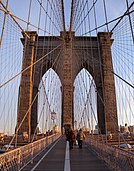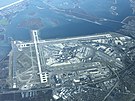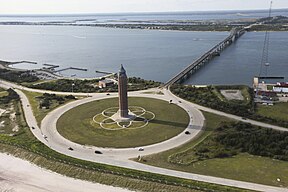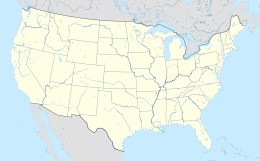
A | B | C | D | E | F | G | H | CH | I | J | K | L | M | N | O | P | Q | R | S | T | U | V | W | X | Y | Z | 0 | 1 | 2 | 3 | 4 | 5 | 6 | 7 | 8 | 9
Native name: Paumanok[1] | |
|---|---|
 Location of Long Island in New York state | |
Location of Long Island in the United States | |
| Geography | |
| Location | Atlantic Ocean |
| Coordinates | 40°48′N 73°18′W / 40.8°N 73.3°W |
| Area | 1,376.1 sq mi (3,564 km2) |
| Highest elevation | 401 ft (122.2 m) |
| Highest point | Jayne's Hill |
| Administration | |
| State | New York |
| Largest settlement | Brooklyn, New York City (pop. 2,736,074) |
| Demographics | |
| Demonym | Long Islander |
| Population | 8,063,232 (2020) |
| Pop. density | 5,859.5/sq mi (2262.37/km2) |
| Ethnic groups | 54.7% White, 20.5% Hispanic or Latino of any race, 20.4% Black, 12.3% Asian, 8.8% other races, 3.2% from two or more races, 0.49% Native American, and 0.05% Pacific Islander |
| Part of a series on |
| Regions of New York |
|---|
 |
| Part of a series on |
| Long Island |
|---|
 |
| Topics |
| Regions |
Long Island is a populous island east of Manhattan in southeastern New York state, constituting a significant share of the New York metropolitan area in both population and land area. The island extends from New York Harbor 118 miles (190 km) eastward into the North Atlantic Ocean with a maximum north–south width of 23 miles (37 km).[2][3] With a land area of 1,401 square miles (3,630 km2), it is the largest island in the contiguous United States.[4]
Long Island is divided among four counties, with Kings (Brooklyn), Queens, and Nassau counties occupying its western third and Suffolk County its eastern two-thirds. As of 2020, most New York City residents (58.4%) lived on Long Island in the outer boroughs of Brooklyn and Queens,[5] although in common parlance, the term "Long Island", locally "the Island", refers exclusively to the counties of Nassau and Suffolk.[6] Conversely, locally, the term "the City" refers to Manhattan alone.[7] The Nassau–Suffolk-only definition of Long Island is recognized as a region by the State of New York.[8] Although geographically an island, the Supreme Court of the United States has held that given the island's extensive ties to the mainland, it should be treated legally as a peninsula, giving the state jurisdiction over its maritime boundaries.[9]
Long Island may refer both to the main island and the surrounding outer barrier islands. To its west, Long Island is separated from Manhattan and the Bronx by the East River tidal estuary. North of the island is Long Island Sound, across which lie Westchester County, New York, and the state of Connecticut. Across the Block Island Sound to the northeast is the state of Rhode Island. Block Island, which is part of Rhode Island, and numerous smaller islands extend farther into the Atlantic Ocean. To the extreme southwest, Long Island, at Brooklyn, is separated from Staten Island and the state of New Jersey by Upper New York Bay, The Narrows, and Lower New York Bay.
With a population of 8,063,232 residents as of the 2020 U.S. census, Long Island constitutes 40% of New York state's entire population.[10][11][12][13][14] Long Island is the most populous island in any U.S. state or territory, the third-most populous island in the Americas after Hispaniola and Cuba, and the 18th-most populous island in the world ahead of Ireland, Jamaica, and Hokkaidō. Its population density is 5,859.5 inhabitants per square mile (2,262.4/km2). If Long Island geographically constituted an independent metropolitan statistical area, it would rank as the fourth-most populous in the United States; if it were a U.S. state, Long Island would rank as the 13th-most populous state and first in population density.
Long Island is culturally and ethnically diverse, featuring some of the wealthiest and most expensive neighborhoods in the world near the shorelines, as well as working-class areas in all four counties.
As of 2022, Kings, Queens, Nassau, and Suffolk counties collectively had a gross domestic product of approximately $500 billion.[15] Median household income on the island significantly exceeds $100,000, and the median home price is approximately $600,000, with Nassau County approximating $700,000. Among residents over the age of 25, 42.6% hold a college degree or higher educational degree.[16] Unemployment on Long Island stays consistently below 4%.
As a hub of commercial aviation, Long Island is home to two of the nation's and New York metropolitan area's busiest airports, JFK International Airport and LaGuardia Airport, both located in Queens.[a] Also located on Long Island are Long Island MacArthur Airport in Ronkonkoma, and two major air traffic control radar facilities, New York TRACON and New York ARTCC.
Long Island has nine major bridges and thirteen navigable tunnels, which connect Brooklyn and Queens to the three other boroughs of New York City. Ferries connect Suffolk County northward across Long Island Sound to Connecticut. Long Island Rail Road is the busiest commuter railroad in North America and operates continuously.[17]
Biotechnology companies, engineering, and scientific research play a significant role in Long Island's economy,[18] including research facilities at Brookhaven National Laboratory, Cold Spring Harbor Laboratory, Stony Brook University, New York Institute of Technology, Plum Island Animal Disease Center, the New York University Tandon School of Engineering, the Zucker School of Medicine, and the Feinstein Institutes for Medical Research.
History
Early history
This section needs additional citations for verification. (March 2023) |
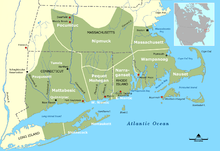


As the last Ice Age waned with Wisconsin glaciation, early Paleo-Indians ventured into the evolving landscapes of present-day Long Island, marking a significant environmental shifts and laying the groundwork for the region's rich ecosystems.[19] These nomadic hunter-gatherers, equipped with stone tools, navigated the newly emerging landscapes, hunting large game and gathering from the abundant natural resources.[20]
Following the Paleo-Indian period, the Archaic Period marked a broadening of subsistence strategies. The inhabitants of Long Island diversified their diet, exploiting the rich marine and terrestrial environments.[19] The main source of protein came from the sea, consisting of fish and shellfish, oysters being of particular importance.[21] Deer and other wild game and various plant foods also became part of their regular diet.[22] The archaeological record also reveals a shift towards a more settled lifestyle, with small bands forming seasonal settlements.[23]
The indigenous peoples in the Early and Middle Woodland period began developing horticulture as well as more efficient strategies for hunting and gathering. They established year-round settlements. Pottery emerged as a widespread technological innovation during this era, serving not only practical storage and cooking purposes but also functioning as a medium for cultural expression. The stylistic variations in pottery across different sites on Long Island suggest a rich diversity of cultural identities and the exchange of ideas among various groups.[24] Additionally, this period was marked by participation in trade networks with other Northeastern Indigenous communities.[25]
During the Late Woodland Period, there was a noticeable intensification of agriculture, with maize becoming a staple crop alongside beans and squash. This agricultural advancement supported larger populations and led to the establishment of more permanent villages characterized by substantial dwellings, mostly wigwams and longhouses.[21] The increased reliance on farming did not eliminate hunting and gathering, which continued to play a crucial role in the subsistence economy.[24]
The Long Island natives lived in villages of differing sizes and their governing style, because of a lack of evidence, can only be guessed. However, anthropological models suggest that the leaders did not have overarching authority over the rest of the village. Rather, the leaders often sought advice from the elders.[22]
The early settlers of Long Island were likely tied by kinship and did not identify themselves as distinct tribes. These tribes were designated by the Europeans as a method of identifying borders. However, there seems to be two, overlapping, but different cultures. Western Long Island natives probably spoke the Delaware-Munsee dialect. The eastern group's language is less well-founded, but it is most likely related to the southern New England Algonquian dialect. The kinship system likely kept Long Island natives together with clans in present-day New Jersey, Massachusetts, Connecticut, and Rhode Island.[26]
Giovanni da Verrazzano was the first European to record an encounter with the Lenape people, after entering what is now New York Bay in 1524, however it is unclear whether he encountered Native Americans from Long Island.
17th century

In 1609, the English navigator Henry Hudson explored the harbor and purportedly landed at present-day Coney Island. Dutch explorer Adriaen Block followed in 1615 and is credited as the first European to determine that both Manhattan and Long Island are islands.
The first recorded encounters between the Algonquian peoples of Long Island and Europeans occurred with the arrival of explorers in the early 17th century, first contacted by Henry Hudson and his crew. These interactions were initially characterized by curiosity and tentative exchanges, but conflicts later emerged between them. Despite this, mutually beneficial trade ensued, with the Algonquian trading fur for clothing, metal, guns, and alcohol.[22]
The Dutch, recognizing the value of New England's fur market, forged long-term alliances with the Algonquians in 1613, ushering in permanent settlements. By 1621, the Dutch West India Company established itself in the Northeast. The Dutch West India Company established a foothold in the Northeast, initiating a lucrative trade in wampum—beads of significant cultural and economic importance to Native tribes across the Northeast. The wampum was primarily made by Long Island Native Americans. The Dutch would thus engage in a triangular trade: purchasing large quantities of wampum from Long Island, exchanging wampum for fur with inland tribes, and shipping the fur back to Europe.[27] This triangular trade created peace amongst the Europeans and the Native Americans for decades.[22]
In 1636, Charles I of England, a Stuart, rewarded Scottish courtier, diplomat, and colonial governor William Alexander's service to the Crown by creating him Lord Alexander of Tullibody and Viscount of Stirling. On April 22 of that year Charles told the Plymouth Colony, which had laid claim to Long Island but had not settled it, to cede it to Alexander. When his agent James Farret arrived in New Amsterdam in 1637 to present his claim of English sovereignty, he was arrested and imprisoned in Holland, but later escaped from prison.
The Pequot War, a struggle over between the Pequot tribe of Connecticut, who exerted control over eastern Long Island, and the English, reshaped alliances and power dynamics in the region. The defeat of the Pequots left a void in eastern Long Island's political landscape, who were historically under the influence of the Connecticut Pequots for trade and protection. Indigenous leaders such as Uncas and Ninigret, alongside the English, vied to fill this vacuum, with the English eventually prevailing with superior military strength and brutality. In 1639, Lion Gardiner secured the first purchase of eastern Long Island land, an islet off of present-day East Hampton.[19]
The period between 1636 and 1648 marked a time of land grabbing in Long Island by the Dutch and the English. The Dutch occupying a small portion of western Long Island while the British dominated the East, buying up land from any sachems that appeared to have power. The perspectives on these land purchases likely varied significantly between Native Americans and Europeans. Europeans viewed land transactions as opportunities for exclusive ownership and permanent settlement, while the Algonquian peoples viewed the transaction as temporary and communal.[28] Additionally, the Native Americans governance style of weak leadership and undefined hunting grounds, did not align with the European's need for strict boundaries. This confusion resulted in conflict and boundary disputes for many years after.
In 1640, English colonists attempted to settle Cow Bay in what is present-day Port Washington. After an alert by Native leader Penhawitz, the colonists were arrested by the Dutch but released after saying they were mistaken about the title.[29]
Through Farret, who received Shelter Island and Robins Island, Alexander in turn sold most of the eastern island to the New Haven and Connecticut colonies.[30]
As European settlers proliferated on Long Island, the ecosystem underwent significant transformation, and the dynamics between Native Americans and Europeans shifted. The Europeans cleared vast areas of traditional hunting grounds and introduced livestock that damaged Native crops.[22] Europeans also began to encroach on Native land, and this growing proximity heightened tensions. This culminated in Kieft's War, initiated by a devastating attack that killed 80 Native Americans.[31]
Despite shifting claims to title and absentee land sales, European settlers continued to purchase land directly from indigenous people. In 1655, they split the acquired land amongst themselves and continued to search the island for more land for settlement. On June 10, 1664, other parts of indigenous land were bought, including present-day Brookhaven, Bellport, and South Haven, in exchange for four coats and 6 pounds 10 shilling - a value that, accounting for monetary inflation through 2017, is currently worth approximately $840.[32]
During King Philip's War in 1675, the English governor of New York ordered that all canoes east of Hell Gate be confiscated. This was done to prevent the indigenous people from helping their native allies on the mainland, who were attacking settlers there.[33] Notable sachems, such as Tackapousha of the Massapequa, saw their influence wane post-King Philip's War in 1675. In the face of escalating tensions between Dutch and English settlers, these Indigenous figures endeavored to mediate and protect their communities. However efforts to maintain land rights were undermined by disease, deceit, infringements of land patents, and cultural misunderstandings.[22]
After the Dutch began to move into Manhattan, many indigenous people moved to Pennsylvania and Delaware. Many of those who stayed behind died from smallpox, which inflicted North American for the first time and resulted in large scale deaths due to lack of antibodies and natural resistance which Eurasian peoples had gained with their exposure to the disease.[34]
Native American land deeds recorded by the Dutch from 1636 state that the Indians referred to Long Island as Sewanhaka. Sewanhacky and Sewanhacking were other spellings in the transliteration of the Lenape.[35] Sewan was one of the terms for wampum, commemorative stringed shell beads, for a while also used as currency by colonists in trades with the Lenape, and is also translated as "loose" or "scattered", which may refer either to the wampum or to Long Island.[35] The name "'t Lange Eylandt alias Matouwacs" appears in Dutch maps from the 1650s,[36][37] with 't Lange Eylandt translating it to "Long Island" from Old Dutch. The English referred to Long Island as "Nassau Island",[38] after the House of Nassau of the Dutch Prince William of Nassau, Prince of Orange (who later also ruled as King William III of England). It is unclear when the name "Nassau Island" was discontinued. Another indigenous name from colonial time, Paumanok, comes from the Native American name for Long Island and means "the island that pays tribute."[39]
The very first European settlements on Long Island were by settlers from England and its colonies in present-day New England. Lion Gardiner settled nearby Gardiners Island. The first settlement on the geographic Long Island itself was on October 21, 1640, when Southold was established by the Rev. John Youngs and settlers from New Haven, Connecticut. Peter Hallock, one of the settlers, drew the long straw and was granted the honor to step ashore first. He is considered the first New World settler on Long Island. Southampton was settled in the same year. Hempstead followed in 1644, East Hampton in 1648, Huntington in 1653, Brookhaven in 1655, and Smithtown in 1665.
While the eastern region of Long Island was first settled by the English, the western portion of Long Island was settled by the Dutch; until 1664, the jurisdiction of Long Island was split between the Dutch and English, roughly at the present border between Nassau County and Suffolk County. The Dutch founded six towns in present-day Brooklyn beginning in 1645. These included: Brooklyn, Gravesend, Flatlands, Flatbush, New Utrecht, and Bushwick. The Dutch had granted an English settlement in Hempstead, New York (now in Nassau County) in 1644, but after a boundary dispute, they drove out English settlers from the Oyster Bay area. However, in 1664, the English returned to take over the Dutch colony of New Netherland, including Long Island.
The 1664 land patent granted to the Duke of York included all islands in Long Island Sound. The Duke of York held a grudge against Connecticut, as New Haven had hidden three of the judges (John Dixwell, Edward Whalley and William Goffe[40]) who sentenced the Duke's father, King Charles I, to death in 1649. Settlers throughout Suffolk County pressed to stay part of Connecticut, but Governor Sir Edmund Andros threatened to eliminate the settlers' rights to land if they did not yield, which they did by 1676.[41]
All of Long Island along with islands between Long Island and Connecticut became part of the Province of New York within the Shire of York. Present-day Suffolk County was designated as the East Riding (of Yorkshire), present-day Brooklyn was part of the West Riding, and present-day Queens and Nassau were part of the larger North Riding. In 1683, Yorkshire was dissolved and the three original counties on Long Island were established: Kings, Queens, and Suffolk.
18th century

Following the British colonization of the Americas, including Long Island, the Algonquian peoples found themselves increasingly marginalized, their ancient hunting grounds cleared for agriculture, and their economic systems integrated into the European market, particularly through their labor and the dwindling fur and wampum trades. By the 18th century, most native lands had been seized, leaving only small parcels, and many Indigenous people were relegated to roles as domestics, laborers, guides, and seamen.[22]
William Floyd was born on Long Island on December 17, 1734. In 1654, his family emigrated to what was then British America. By the time of Floyd's birth, the family was established and wealthy. He was a member of the Suffolk County Militia in the beginning of the American Revolution, and rose to the rank of Major General. In 1774, he was chosen as a representative from New York to the First Continental Congress. His property was destroyed by the British Army and Tory sympathizers. In 1789, Floyd was elected to the U.S. House of Representatives, where he served until 1791. Francis Lewis from Brookhaven on Long Island, another signer of the Declaration of Independence, also had his home destroyed by the British, who then imprisoned his wife. George Washington managed her release by having the wives of two wealthy Tories from Philadelphia arrested, and then exchanging the two for Mrs. Lewis.
Marinus Willett, of Jamaica, Queens enlisted in the colonial militia after the French and Indian War broke out in 1754. He participated in the Ticonderoga campaign and the capture of Fort Frontenac in 1758. Joining the revolutionary Sons of Liberty in the 1770s, Willett shortly thereafter enlisted in the Continental Army in 1775. Serving in the 1st New York, he took part in the Invasion of Quebec before transferring to the 3rd New York in 1776. Seeing action at Monmouth, Willett then participated in the 1778 Sullivan Campaign. He was made the colonel of the 5th New York in 1780 and the Tryon County militia in 1781, where he fought at Johnstown. On August 22, 1830, Willett died and was buried in the graveyard of Trinity Church. The Willets Point and the accompanying Mets-Willets Point station is named in his honor.
Early in the American Revolutionary War, the island was captured by the British from General George Washington in the Battle of Long Island, a decisive battle after which Washington narrowly evacuated his troops from Brooklyn Heights under a dense fog. After the British victory on Long Island, many Patriots withdrew, leaving mostly Loyalists behind. The island was a British stronghold until the end of the war in 1783.[42]
General Washington based his espionage activities on Long Island, due to the western part of the island's proximity to the British military headquarters in New York City. The Culper Spy Ring included agents operating between Setauket and Manhattan. This ring alerted Washington to valuable British secrets, including the treason of Benedict Arnold and a plan to use counterfeiting to induce economic sabotage.[citation needed]
Long Island's colonists served both Loyalist and Patriot causes, with many prominent families divided among both sides. During the occupation, British troops used a number of civilian structures for defense and demanded to be quartered in the homes of civilians. A number of structures from this era remain. Among these are Raynham Hall, the Oyster Bay home of patriot spy Robert Townsend, and the Caroline Church in Setauket, which contains bullet holes from a skirmish known as the Battle of Setauket. Also in existence is a reconstruction of Brooklyn's Old Stone House, on the site of the Maryland 400's celebrated last stand during the Battle of Long Island.[43]
19th century
In the 19th century, Long Island was still mainly rural and devoted to agriculture. The predecessor to the Long Island Rail Road (LIRR) began service in 1836 from the South Ferry in Brooklyn, through the remainder of Brooklyn, to Jamaica in Queens. The line was completed to the east end of Long Island in 1844, as part of a plan for transportation to Boston. Competing railroads, soon absorbed by the LIRR, were built along the south shore to accommodate travelers from those more populated areas. For the century from 1830 until 1930, total population roughly doubled every twenty years, with more dense development in areas near Manhattan. Several cities were incorporated, such as the "City of Brooklyn" in Kings County, and Long Island City in Queens.[44][45]
Until completion of the Brooklyn Bridge in 1883, the only means of travel between Long Island and the rest of the United States was by boat or ship. As other bridges and tunnels were constructed, areas of the island began to be developed as residential suburbs, first around the railroads that offered commuting into the city. On January 1, 1898, Kings County and portions of Queens County were consolidated into the City of Greater New York, abolishing all cities and towns within them. The easternmost 280 square miles (730 km2) of Queens County, which were not part of the consolidation plan,[46][47][48][49][50][51] separated from Queens in 1899 to form Nassau County.
At the close of the 19th century, wealthy industrialists who made vast fortunes during the Gilded Age began to construct large "baronial" country estates in Nassau County communities along the North Shore of Long Island, favoring the many properties with water views. Proximity to Manhattan attracted such men as J. P. Morgan, William K. Vanderbilt, and Charles Pratt, whose estates led to this area being nicknamed the Gold Coast. This period and the area was immortalized in fiction, such as F. Scott Fitzgerald's The Great Gatsby, which has also been adapted in films.
20th century


The gradual decline in Indigenous authority reached a critical point when it led to the formal obliteration of acknowledgement for many tribes. A poignant example of this phenomenon occurred in 1910, when a legal decree by New York State pronounced the Montaukett "tribe" extinct, ignoring the presence and testimonies of its members in court. Such decrees were used to facilitate the encroachment on Native American lands with greater ease, granting legal legitimacy to the acts of settler colonialism. In the absence of legally recognized Indigenous territories, settlers could assert ownership over Native lands without engaging in negotiations or offering compensation. This act represented the final stage in the thorough domination and displacement of Native American communities on Long Island.[52]
Charles Lindbergh lifted off from Roosevelt Field with his Spirit of Saint Louis for his historic 1927 solo flight to Europe, one of the events that helped to establish Long Island as an early center of aviation during the 20th century. Other famous aviators such as Wiley Post originated notable flights from Floyd Bennett Field in Brooklyn, which became the first major airport serving New York City before it was superseded by the opening of La Guardia Airport in 1939. Long Island was also the site of Mitchel Air Force Base and was a major center of military aircraft production by companies such as Grumman and Fairchild Aircraft during World War II and for some decades afterward. Aircraft production on Long Island extended all the way into the Space Age. Grumman was one of the major contractors that helped to build the early lunar flight and Space Shuttle vehicles. Although the aircraft companies eventually ended their Long Island operations and the early airports were all later closed. Roosevelt Field, for instance, became the site of a major shopping mall, the Cradle of Aviation Museum on the site of the former Mitchel Field documents the Island's key role in the history of aviation.
From the 1920s to the 1940s, Long Island began the transformation from backwoods and farms as developers created numerous suburbs. Numerous branches of the Long Island Rail Road (LIRR) already enabled commuting from the suburbs to Manhattan. Robert Moses engineered various automobile parkway projects to span the island, and developed beaches and state parks for the enjoyment of residents and visitors from the city. Gradually, development also followed these parkways, with various communities springing up along the more traveled routes.
After World War II, suburban development increased with incentives under the G.I. Bill, and Long Island's population skyrocketed, mostly in Nassau County and western Suffolk County. Second and third-generation children of immigrants moved out to eastern Long Island to settle in new housing developments built during the post-war boom. Levittown became noted as a suburb, where housing construction was simplified to be produced on a large scale. These provided opportunities for white World War II military veterans returning home to buy houses and start a family. In his 1966 book, My Private America (Moja prywatna Ameryka), Kazimierz Wierzyński, a Polish poet who could not go back to Poland after World War II, describes Polish farmers living there, as "walking novels".[53]
21st century

At the beginning of the 21st century, a number of Long Island communities had converted their assets from industrial uses to post-industrial roles. Brooklyn reversed decades of population decline and factory closings to resurface as a globally renowned cultural and intellectual hotbed. Gentrification has impacted much of Brooklyn and a portion of Queens, relocating a sizeable swath of New York City's population. On eastern Long Island, Port Jefferson, Patchogue, and Riverhead evolved from inactive shipbuilding and mill towns into tourist-centric commercial centers with cultural attractions.
The descendants of late 19th and early 20th-century immigrants from southern and Eastern Europe, and Black migrants from the South, were followed by more recent immigrants from Asia and Latin America. Long Island has many ethnic Irish, Jews, and Italians. In later immigration trends, Asians, Hispanics, Afghans, Arabs, and Indians arrived on Long Island.
Geography



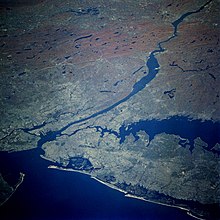


The westernmost end of Long Island contains the New York City boroughs of Brooklyn (Kings County) and Queens (Queens County). The central and eastern portions contain the suburban Nassau and Suffolk counties. However, colloquial usage of the term "Long Island" usually refers only to Nassau and Suffolk counties. For example, the Federal Reserve Bank of New York has a district named "Long Island (Nassau-Suffolk Metro Division)."[54] At least as late as 1911, locations in Queens were still commonly referred to as being on Long Island.[55] Some institutions in the New York City section of the island use the island's names, like Long Island University and Long Island Jewish Medical Center.
In 1985, the U.S. Supreme Court ruled in United States v. Maine that Long Island is integrally related to the mainland enough that Long Island Sound and the western part of Block Island Sound constitute a "juridical bay" for the purpose of determining maritime state boundaries.[56] In the popular media, this has been often misinterpreted as a ruling that Long Island is legally not an island.[57][58][59] The United States Board on Geographic Names still considers Long Island an island, because it is surrounded by water.[60]
There are few tall buildings on Long Island. Nassau County is more densely developed than Suffolk County. While affluent overall, Nassau County has pockets of more pronounced wealth with estates covering greater acreage within the Gold Coast of the North Shore and the Five Towns area on the South Shore. South Shore communities are built along protected wetlands of the island and contain white sandy beaches of Outer Barrier Islands fronting on the Atlantic Ocean. Dutch and English settlers from the time before the American Revolutionary War, as well as communities of Native Americans, populated the island. The 19th century saw the infusion of the wealthiest Americans in the so-called Gold Coast of the North Shore, where wealthy Americans and Europeans in the Gilded Age built lavish country homes.
In its easternmost sections, Suffolk County remains semi-rural, as in Greenport on the North Fork and some of the periphery of the area prominently known as The Hamptons, although summer tourism swells the population in those areas. The North Fork peninsula of Suffolk County's East End has developed a burgeoning wine region.[61] In addition, the South Fork peninsula is known for beach communities, including the Hamptons, and for the Montauk Point Lighthouse at the eastern tip of the island. The Pine Barrens is a preserved pine forest encompassing much of eastern Suffolk County.
Geology
A detailed geomorphological study of Long Island provides evidence of glacial history of the kame and terminal moraines of the island which were formed by the advance and retreat of two ice sheets.[62] Long Island, as part of the Outer Lands region, is formed largely of two spines of glacial moraine, with a large, sandy outwash plain beyond. These moraines consist of gravel and loose rock left behind during the two most recent pulses of Wisconsin glaciation during the ice ages some 21,000 years ago (19,000 BC). The northern moraine, which directly abuts the North Shore of Long Island at points, is known as the Harbor Hill moraine. The more southerly moraine, known as the Ronkonkoma moraine, forms the "backbone" of Long Island; it runs primarily through the very center of Long Island, roughly coinciding with the length of the Long Island Expressway.
The land to the south of this moraine to the South Shore is the outwash plain of the last glacier. One part of the outwash plain was known as the Hempstead Plains, and this land contained one of the few natural prairies to exist east of the Appalachian Mountains.[63] The glaciers melted and receded to the north, resulting in the difference between the topography of the North Shore beaches and the South Shore beaches. The North Shore beaches are rocky from the remaining glacial debris, while the South Shore's are crisp, clear, outwash sand. Jayne's Hill, at 401 feet (122 m), within Suffolk County near its border with Nassau County, is the highest hill along either moraine; another well-known summit is Bald Hill in Brookhaven Town, not far from its geographical center at Middle Island. The glaciers also formed Lake Ronkonkoma in Suffolk County and Lake Success in Nassau County, each a deep kettle lake.
Countyscapes
Climate
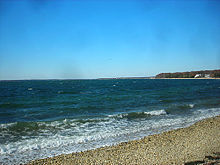



Under the Köppen climate classification, Long Island lies in a transition zone between a humid subtropical climate (Cfa) and a hot-summer humid continental climate (Dfa).[65] The climate features hot, usually humid summers with occasional thunderstorms, mild spring and fall weather, and cool winters with a mix of snow and rain and stormier conditions. Spring can be cool due to the relatively cooler temperatures of the Atlantic Ocean and occasional blocking. Thunderstorms rarely form directly over Long Island, but can form over inland areas and then move eastward. Some storms may weaken as they approach Long Island due to the moderating effects of the Atlantic Ocean. The ocean also brings afternoon sea breezes to the immediate South Shore areas (within 1 mile (1.6 km)) that temper the heat in the warmer months. The temperatures south of Sunrise Highway (NY Route 27) tend to be significantly cooler than the rest of Long Island in the spring and summer months because of the relatively cooler temperatures of the Atlantic Ocean. Long Island has a moderately sunny climate, averaging 2,400 to 2,800 hours of sunshine annually.[66]
Due to its coastal location, Long Island winter temperatures are milder than most of the state. The coldest month is January, when average temperatures range from 25 to 45 °F (−4 to 7 °C), and the warmest month is July, when average temperatures range from 74 to 85 °F (23 to 29 °C).[67] Temperatures seldom fall below −5 °F (−21 °C) or rise above 100 °F (38 °C). Coldest temp ever recorded on Long Island was −23 °F (−31 °C) on January 22, 1961. Long Island temperatures vary from west to east, with the western part (Nassau County, Queens, and Brooklyn) generally 2 to 3 degrees F (1 to 2 degrees C) warmer than the east (Suffolk County). This is due to several factors: the western part is closer to the mainland and more densely developed, causing the "urban heat island" effect, and Long Island's land mass veers northward as one travels east. Also, daytime high temperatures on the eastern part of Long Island are cooler on most occasions, due to the moderating effect of the Atlantic Ocean and Long Island Sound. On dry nights with no clouds or wind, the Central Part of Suffolk County and Pine Barrens forest of eastern Suffolk County can be almost 5 to 10 F (3 to 5 C) cooler than the rest of the island, due to radiational cooling. Average dew points, a measure of atmospheric moisture, typically lie in the 60–70 °F (16–21 °C) range during July and August.
Precipitation is distributed uniformly throughout the year, with approximately 3–4 inches (76–102 mm) on average during each month. Average yearly snowfall totals range from approximately 20 to 35 inches (51 to 89 cm), with the north shore and western parts averaging more than the immediate south shore (South of Sunrise Hwy) and the east end. In any given winter, however, some parts of the island can see up to 50 inches (130 cm) of snow or more. There are also milder winters, in which much of the island see less than 10 inches (25 cm) of snow.
On August 13, 2014, flash flooding occurred in western-central Suffolk County after a record-setting rainfall deposited more than three months' worth of precipitation on the area within a few hours.[68]
Long Island is somewhat vulnerable to tropical cyclones.[69] While it lies north of where most tropical cyclones turn eastward and out to sea (most landfalls on the East Coast of the U.S. occur from North Carolina southward), several tropical cyclones have struck Long Island, including a devastating Category 3, the 1938 New England hurricane (also known as the "Long Island Express"), and another Category 3, Hurricane Carol in 1954. Other 20th-century storms that made landfall on Long Island at hurricane intensity include the 1944 Great Atlantic hurricane, Hurricane Donna in 1960, Hurricane Belle in 1976, and Hurricane Gloria in 1985. Also, the eyewall of Hurricane Bob in 1991 brushed the eastern tip. In August 2011, portions of Long Island were evacuated in preparation for Hurricane Irene, a Category 1 hurricane which weakened to a tropical storm before it reached Long Island.[70]
On October 29, 2012, Hurricane Sandy caused extensive damage to low-lying coastal areas of Nassau and Suffolk counties, Brooklyn, and Queens, destroying or severely damaging thousands of area homes and other structures by ocean and bay storm surges. Hundreds of thousands of residents were left without electric power for periods of time ranging up to several weeks while the damage was being repaired. The slow-moving "Superstorm Sandy" (so-nicknamed because it merged with a nor'easter before it made landfall) caused 90% of Long Island households to lose power and an estimated $18 billion in damages in Nassau and Suffolk counties alone.[71][72] The storm also had a devastating impact on coastal communities in the Brooklyn and Queens portions of the island, including Coney Island in Brooklyn and the Rockaway Peninsula in Queens, although estimates of monetary damages there are usually calculated as part of the overall losses suffered in New York City as a whole. When allowance is made for inflation, the extent of Sandy's damages is second only to that of those caused by the 1938 Long Island Express. Although a lower central pressure was recorded in Sandy, the National Hurricane Center estimates that the 1938 hurricane had a lower pressure at landfall.[73][74][full citation needed] Hurricane Sandy and its profound impacts have prompted the discussion of constructing seawalls and other coastal barriers around the shorelines of Long Island and New York City to minimize the risk of destructive consequences from another such event in the future.[75][76]
| Climate data for Islip, New York (Long Island MacArthur Airport), 1991–2020 normals,[b] extremes 1963–present | |||||||||||||
|---|---|---|---|---|---|---|---|---|---|---|---|---|---|
| Month | Jan | Feb | Mar | Apr | May | Jun | Jul | Aug | Sep | Oct | Nov | Dec | Year |
| Record high °F (°C) | 69 (21) |
71 (22) |
82 (28) |
94 (34) |
98 (37) |
96 (36) |
104 (40) |
100 (38) |
94 (34) |
89 (32) |
80 (27) |
77 (25) |
104 (40) |
| Mean maximum °F (°C) | 58.2 (14.6) |
57.1 (13.9) |
66.7 (19.3) |
77.0 (25.0) |
85.8 (29.9) |
90.4 (32.4) |
94.0 (34.4) |
91.2 (32.9) |
86.0 (30.0) |
78.6 (25.9) |
68.8 (20.4) |
60.9 (16.1) |
95.6 (35.3) |
| Mean daily maximum °F (°C) | 39.2 (4.0) |
41.0 (5.0) |
47.7 (8.7) |
58.3 (14.6) |
68.3 (20.2) |
77.2 (25.1) |
82.8 (28.2) |
81.4 (27.4) |
74.8 (23.8) |
64.1 (17.8) |
53.6 (12.0) |
44.4 (6.9) |
61.1 (16.2) |
| Daily mean °F (°C) | 31.9 (−0.1) |
33.3 (0.7) |
39.9 (4.4) |
49.7 (9.8) |
59.5 (15.3) |
69.0 (20.6) Zdroj:https://en.wikipedia.org?pojem=Eastern_Long_Island Text je dostupný za podmienok Creative Commons Attribution/Share-Alike License 3.0 Unported; prípadne za ďalších podmienok. Podrobnejšie informácie nájdete na stránke Podmienky použitia.
Analytika
Antropológia Aplikované vedy Bibliometria Dejiny vedy Encyklopédie Filozofia vedy Forenzné vedy Humanitné vedy Knižničná veda Kryogenika Kryptológia Kulturológia Literárna veda Medzidisciplinárne oblasti Metódy kvantitatívnej analýzy Metavedy Metodika Text je dostupný za podmienok Creative
Commons Attribution/Share-Alike License 3.0 Unported; prípadne za ďalších
podmienok. www.astronomia.sk | www.biologia.sk | www.botanika.sk | www.dejiny.sk | www.economy.sk | www.elektrotechnika.sk | www.estetika.sk | www.farmakologia.sk | www.filozofia.sk | Fyzika | www.futurologia.sk | www.genetika.sk | www.chemia.sk | www.lingvistika.sk | www.politologia.sk | www.psychologia.sk | www.sexuologia.sk | www.sociologia.sk | www.veda.sk I www.zoologia.sk | |||||||



